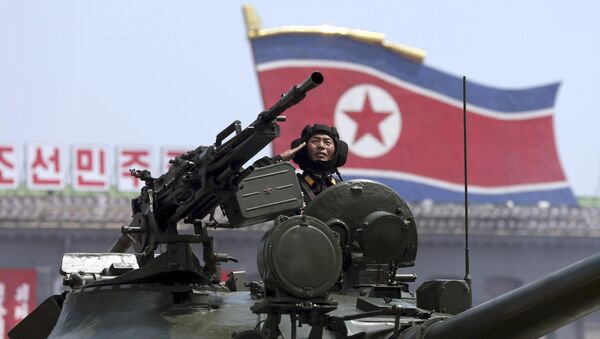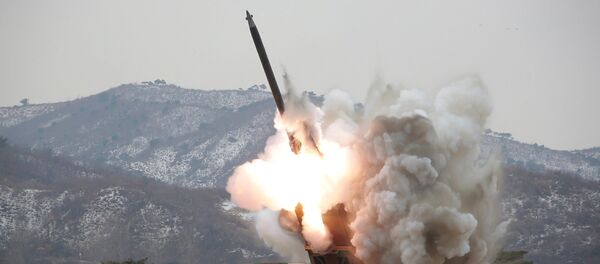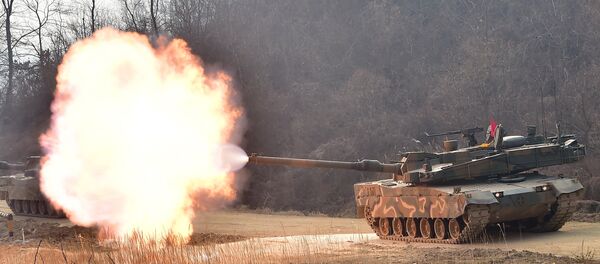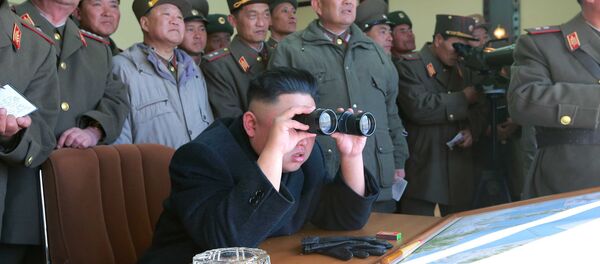In his analysis, published by the independent Russian news website Svobodnaya Pressa, Sivkov, the head of the Moscow-based Academy of Geopolitical Problems, takes a broad look at the defensive and offensive capabilities of the two Koreas.
Korean People's Army: Colossus With Obsolete Feet
"Despite being equipped with obsolete equipment, North Korea's armed forces are quite powerful, with over a million troops. A 4.5 million-strong trained reserve makes it possible for military and political leaders to deploy a force consisting of several million men," the analyst noted.
"However, the offensive capabilities of its ground forces in the present circumstances would be very limited, due to its outdated tank fleet," Sivkov added.
At the same time, North Korea's "mountainous terrain, prepared shelters and weapons stockpiles would allow the country to conduct a massive guerrilla campaign that could last for years, forcing the aggressor to devote substantial ground forces to suppress insurgents. Based on the [US's recent] experience in Afghanistan and Iraq, the required forces might comprise 200,000 men or more."
The size of North Korea's special operations forces, Sivkov noted, would "allow them to deploy an effective diversionary campaign, with dozens of subversive groups in the enemy's operational or even strategic depth – that is, across almost the entire territory of South Korea."
The DPRK's operational-tactical and tactical missile systems, meanwhile, each armed with up to 50 missiles, "would allow them to strike at targets in tactical and operational depth."
Taking account of enemy countermeasures, Sivkov estimates that this firepower would allow the North's ground forces to at least temporarily incapacitate (disable or destroy) between 10-15 enemy objects, including airfields, command posts and communications centers. South Korea's small land area factually allows the North's operational-tactical systems to threaten the entire depth in which enemy operational groups are located.
The DPRK has a small number of Taepodong-1 and Taepodong-2 medium-range missiles. "Armed with conventional warheads, their limited accuracy would [likely] allow them to cause significant damage to a maximum of one American base. The believed reserves of nuclear weapons, meanwhile, mean that North Korea could launch between one and five strikes on military targets in South Korea, Japan, and the US, depending on the effectiveness of the US missile defense system."
"The country's air defense capabilities, on the other hand, are significantly stronger. While stationary anti-aircraft missiles would likely be destroyed in the first 3-4 days, mobile air defense systems would, for the most part, be able to maintain their combat capability, forcing the enemy to allocate significant resources to support strike groups. The presence of significant numbers of anti-aircraft artillery would prevent enemy aircraft from flying at low altitudes to identify and destroy equipment and facilities from North Korea's ground forces."
"Together with effective maskirovka [operational camouflage], all of this would jeopardize the success of the enemy air offensive, even with a significant quantitative and qualitative superiority of their aircraft." The country's mountainous topography would provide a separate challenge, Sivkov notes.
Effectively, the military analyst estimates, "ensuring the success of the air campaign would require the US, South Korea and its allies to create an aviation group consisting of no less than 800 planes of various classes."
"Mines," Sivkov writes, "would pose the main threat to the enemy fleet. A large number and variety of mines allow the DPRK to create dense minefields, whose defusing would require a significant mine-sweeping force and a great deal of time. If the fields are protected by [mobile] coastal artillery and ground-based anti-ship missile complexes, any de-mining campaign would be accompanied by significant losses. Ultimately, it is North Korea's capabilities in mine warfare which could jeopardize the potential enemy's capability to conduct amphibious landing operations."
The country's mountainous terrain, along with a system of fortifications, underground tunnels and facilities located deep underground (over 100 meters in mountain ranges), would allow the DPRK to hide large forces, including tactical nuclear weapons and even armor, field artillery and missile launchers, from enemy air attack.
Moreover, "military experts believe that the army is well trained, and its officers have a high level of operational training. Political indoctrination and soldiers' mentality denotes a very low sensitivity to losses and the willingness to fight to the last soldier."
Ultimately, "assessing the armed forces of the DPRK on the whole, it can be said that they are capable of conducting an effective defensive action even against a high-tech enemy with total air superiority. However, a North Korean army offensive against such an enemy would be accompanied by extremely heavy losses and very dubious chances for success."
ROK Armed Forces: High-Tech but Fragile
"The DPRK's main opponent on the Korean peninsula, the Republic of Korea, also has a rather large military; unlike their northern neighbors, they are equipped with mostly modern military equipment," Sivkov continues. In theory, "the ROK's ground forces are capable of conducting successful offensive and defensive operations on the army scale," he adds.
"However, when taking terrain and the scale of the fortifications in southern North Korea into account, the South Korean Army would be unlikely to be able to effectively use their offensive capabilities against their northern neighbors."
"The ROK's air defense systems [would] almost completely eliminate any threat posed by North Korea's Air Force. The deployment of the THAAD missile defense system on South Korean territory and elements of strategic missile defense would allow them to defend against individual ballistic missile launches from the DPRK. However, a grouped launch threatens the probability of enemy missiles reaching their designated targets."
"The South Korean Navy is capable of independently reaching naval supremacy in its operating area," Sivkov notes. However, the Navy's limited mine-sweeping capability would limit its ships' ability to maneuver within enemy waters, at least in the short term. The Navy's also has limited capabilities to work to suppress enemy coastal defenses. Together, this would limit the South Korean Navy's capabilities in conducting successful amphibious operations.
Moreover, while training and officers' operational training levels are sufficiently high, Sivkov suggests that South Koreans would be "much more sensitive to combat losses."
Strategic Ying & Yang
"On the whole," the military analyst notes, "when assessing the military capabilities of the two Koreas, it can be said that there is parity between their military forces: technological superiority by the armed forces of South Korea, offset by numerical superiority and the 'moral potential' [i.e. indoctrination and lower sensitivity to taking losses] advantage of the North Korean army."
"The South Korean Air Force cannot suppress the North's deeply echeloned system of anti-aircraft defenses, while the North Korean Air Force doesn't have the modern aviation necessary for a successful offensive against its southern neighbor."
"South Korea's Navy is capable of mastering the seas, but the value of such an effort would be offset by their inability to effectively combat the threat of landmines and to provide effective assistance to any possible coastal flank for its armies via naval firepower."
Ultimately, Sivkov notes, "what we see here is a rare case in military history, where the defensive potential of both sides far exceeds their offensive capabilities. Nevertheless, tensions on the Korean peninsula continue to grow, and serious military capabilities are already concentrated there, which can be significantly enhanced by the armed forces of other countries."







